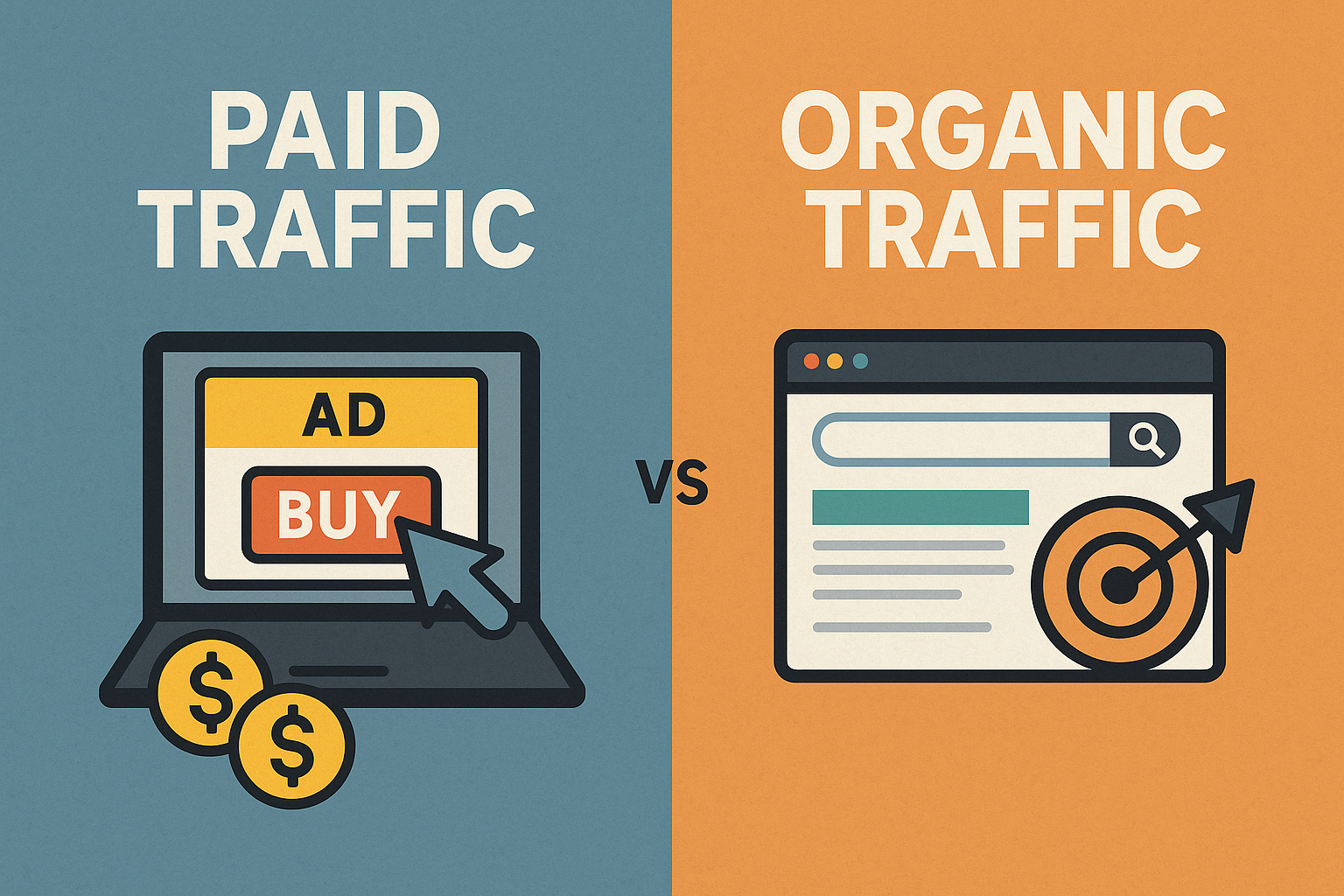If you’re learning digital marketing or planning to work as a traffic manager, you’ll constantly hear two key terms: paid traffic and organic traffic. While they both refer to users visiting a website or landing page, the strategies, tools, timelines, and costs are very different.
In this article, we’ll explore the key differences between these two types of traffic, their pros and cons, and help you decide which is best for different goals or business stages.
What Is Paid Traffic?
Paid traffic refers to visitors who land on a website or landing page after clicking on an advertisement. These ads are created and managed through platforms like:
Meta Ads (Facebook and Instagram)
Google Ads (Search, Display, YouTube)
TikTok Ads
LinkedIn Ads
Pinterest Ads
Twitter/X Ads
Paid traffic is immediate and targeted, meaning you pay to put your message in front of a specific audience based on interests, behaviors, search terms, or demographics.
Example:
A local gym wants more sign-ups. They create a Facebook ad targeting people aged 22–45 who live within 10 km and have an interest in fitness. Everyone who clicks on the ad becomes paid traffic.
What Is Organic Traffic?
Organic traffic refers to users who discover your website or content naturally, without the influence of paid ads. Most organic traffic comes from:
Google Search (SEO)
YouTube Search
Social media (non-sponsored posts)
Email newsletters
Word of mouth or direct links
Organic traffic is free, but it takes time and effort to build. It relies on content marketing, consistency, and good SEO practices.
Example:
A food blog publishes a recipe for gluten-free brownies. After a few months, it starts ranking on Google for the keyword “easy gluten-free brownies” and gets hundreds of clicks a day — all organic.
Key Differences Between Paid and Organic Traffic
Feature Paid Traffic Organic Traffic
Speed Instant results Slow, long-term growth
Cost Requires ad budget Free, but time-intensive
Sustainability Short-term unless maintained Long-term with consistent effort
Scalability Easily scalable with money Harder to scale quickly
Audience Control Precise targeting Depends on SEO and content appeal
Tracking Advanced metrics & pixel data Limited unless using SEO tools
Trust Level Sometimes seen as promotional Often seen as more trustworthy
Pros and Cons of Paid Traffic
✅ Pros:
Fast results: You can test an idea or product immediately.
Highly targeted: You control who sees your ad.
Data-rich: Pixels and analytics give precise performance insights.
Scalable: If a campaign works, you can increase the budget to grow.
❌ Cons:
Costs money: You pay for every click or impression.
Requires experience: Mistakes can be costly.
Short-term: When the budget stops, the traffic disappears.
Ad fatigue: Audiences may tire of seeing the same ads.
Pros and Cons of Organic Traffic
✅ Pros:
Free traffic: No cost per click or impression.
Trust and authority: People often trust non-sponsored content.
Sustainable: A well-ranked blog or video can drive traffic for years.
Better engagement: Organic users often stay longer and interact more.
❌ Cons:
Takes time: SEO and content growth are slow.
Algorithm dependent: Google updates or social platform changes can hurt results.
Not immediate: Not ideal for urgent promotions or launches.
Requires content creation: You’ll need to publish consistently.
When to Use Paid Traffic
Paid traffic is ideal when you need:
Fast results for a product launch
To test an offer or validate a funnel
To scale an e-commerce store
Immediate lead generation for services
Retargeting users who didn’t convert the first time
Running campaigns for limited-time offers
If you’re starting a brand, service, or product and want to get traction quickly, paid traffic is the best tool in your toolkit.
When to Focus on Organic Traffic
Organic traffic is perfect for:
Building long-term authority
Establishing a niche blog or YouTube channel
Growing a personal or business brand
Reducing dependency on ad costs
Supporting a paid traffic strategy with inbound content
If you’re thinking long-term and want to build a brand that people trust, content marketing and SEO should be part of your strategy.
Can You Combine Both?
Absolutely — and that’s often the smartest approach.
Here’s how you can combine them:
- Use paid traffic to test ideas quickly — ads help you gather data fast.
- Create organic content based on ad performance — turn winning ads into blog posts, YouTube videos, or SEO articles.
- Use paid retargeting to bring back organic users — people who visited your blog can be shown ads later.
- Invest in organic content to reduce long-term costs — over time, your blog and videos will generate free traffic, allowing you to rely less on paid ads.
What Traffic Managers Need to Know
If you want to become a successful traffic manager, you don’t need to be an SEO expert — but you must understand how paid and organic traffic support each other.
Great traffic managers:
Launch paid campaigns quickly
Interpret data from organic sources
Coordinate with content teams
Use blog or video content as ad creatives
Optimize user journeys based on all sources
Understanding the full ecosystem makes you more valuable to any client or company.
Final Thoughts: Which One Should You Choose?
There’s no one-size-fits-all answer. Both paid and organic traffic are essential in digital marketing. The best strategy depends on your:
Budget
Timeline
Business goals
Audience behavior
Industry or niche
For beginners, paid traffic offers faster results and data. For long-term growth, organic traffic builds authority and resilience.
But if you want to truly thrive as a traffic manager — learn both, combine them, and adapt them to every situation. That’s the real secret to success in 2025 and beyond.
